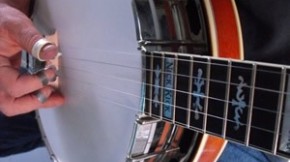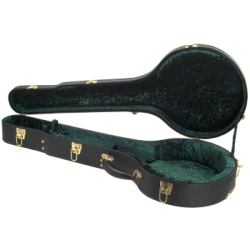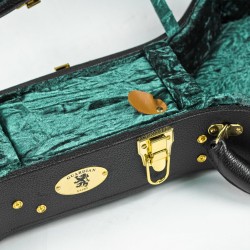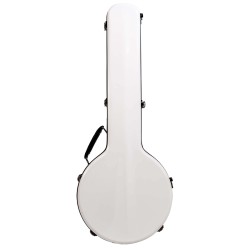Blog search
Blog categories
More Resources
Blog archives
Latest Comments
Martha Butler
on Fixing Banjo Timing - Banjo Tab ExercisesGeorge Hicks
on How Hard is it to Play the Banjo?Thomas Holder
on Banjo Capo Advice - How and When to Use a Banjo...Bryan Cook
on Banjo Capo Advice - How and When to Use a Banjo...

Traveling with a banjo, what’s the best way to fly?
Traveling with a banjo, what’s the best way to fly?
I am asked for advice on the best way to fly with a banjo a lot especially by students in conjunction with our annual Banjo Camps and Workshops that I organize and instruct at. I am a good person to ask because I certainly have flown a lot with my banjo and have tried a number of different strategies and approaches.
First I should say it can be done safely. I know for many of you that are not professional musicians your banjo is an expensive investment that does not leave your house that often. It can be very scary thought turning over your prized possession to airline counter agents and their bag slinging luggage handlers. In this article of free tips on flying with your banjo below I will share a lot of experience in traveling with my banjo. I’ll include a couple of bad experiences too but how can one learn how to navigate the murky waters of traveling on an airplane with a banjo without learning a couple of things the hard way.
Let’s start with some practical advice
Just about any hard case will protect the banjo from being crushed but that is not the problem. The biggest thing you have to protect the banjo against is breaking itself against the inside of your hard case. This can happen if the banjo is dropped.
So, your job in preparation to fly with your banjo is to pack the banjo inside its case very tightly so it cannot move even slightly. Pack socks or padding between the resonator and case, stuff and fill the area where the heel of the neck is between the accessories compartment and heel. Next pad the space between the peghead and the end of the case well and fill all the empty space in that area too. Make sure your banjo neck is resting all the way against the support at the end of the accessories compartment, don’t let the padding you add around the peg head push it off the neck rest. Most good cases fit snug on top but if yours doesn’t make sure that it does fit snugly on top too. Again, the banjo should not be able to move inside the case in any direction.
Another thing you must guard against is the latches coming unbuckled and the banjo falling out. If your case seems flimsy at all in that regard, tape the latches shut. The locks on cases are generally not very good so I would not rest your concerns on the lock.
What to do with the bridge and strings?
Many banjo players drop the bridge and loosen the strings. I found that taking all the tension off the bridge has caused my action to fluctuate when I get to my destination. I prefer to tune my banjo down a whole step or a whole step and a half and leave it in tune. (I’m superstitious that way, I like to keep my banjo in tune even if it’s a step and half lower). That also will keep a consistent pressure on the neck which again helps keep my neck action where it was when I left and also save wear on my strings. Since using this approach I have not had any problem with the action changing in flight.
In addition to these steps the most protective way to travel with a banjo is to use a case within a case.
The best deal on a flight case right now is the new Fiberglass Case that Gold Tone uses for their Bela Fleck Signature Model Banjo, the OB-Bela. It can be purchased separately and is very reasonably priced. It's similar and very comparable to the popular Calton case which I have used in the pas but for about 1/3 the price.
It also comes with a back pack strap so you can carry it on your back like a backpack in the airport. GT Fiberglass Case.
Other Cases I use or have used
Although the new Fiberglass case I mentioned above has back pack straps for the case, another method I've used before that was I bought a separate hard case cover. I purchased a high quality nylon hardshell case cover with added back pack straps from “Colorado Case Company”. I purchased that for around 230.00 in 2016. This works great with the fiberglass case. I take off the back pack straps when I check it so they don't get caught in the luggage machines or carts. “Colorado Case” is the name of the company that makes them. This Colorado Case hard case cover with shoulder straps would work on a normal plywood hard case as long as you verified the size. It’s my opinion that a good quality hard case will do the job just as well as long as you pack it tight inside and it has good buckles on the case that won’t open on you. It’s always a good idea to tape them shut too. There are some low grade hard cases out there, watch out for them, you should be able to tell how good a hard case by looking it over and using your best judgment. The two best AND most affordable highest quality plywood cases with plush interior are the Superior Hard Case made by Saga or the Guardian CG-044-J .
Putting it in a Box
Another cheap alternative is packing your hard case in a box like UPS ships in. The airlines will take it like this and hey, if UPS can’t break one shipping ground across the US, your banjo will likely be OK with a few connections. I have done this too. The only hitch in this plan is you’ll need a place to keep the box at your destination and it’s hard to carry in the airport without a cart.
Afraid of the airlines losing the banjo?
Watch out for Air Canada. They notoriously have the worst reputation among musicians that I have heard. One way to avoid misplaced instruments is to not book tight connections. I taught a bluegrass camp and one of the faculty spent most of the week fuming over Air Canada. Not too long after, sure enough after a tight connection in Montreal on Air Canada, 7 days later my banjo was found in a back room at my destination. I was miserable calling them for seven days and speaking to someone with poor English in India. In Canada, fly West Jet airlines with your banjo, they are great, or insure it, or fly direct, or pray. I’m not impressed with Air Canada after losing my banjo for 7 days and stressing me out but even Air Canada only lost it once out of ten flights or so.
(Update, 2016, evidently Air Canada has come a long way, (not sure about losing items which was my issue) but my Canadian friends report more leniency on carrying instruments on board, a more understanding attitude and other flight benefits that are specifically for musicians.
My intentions is to not scare or discourage anyone. The most useful part of any venting I am doing is to help you prepare, not discourage you from traveling with your instrument. Have no fear! but anticipate lots of scenarios.
Traveling on an airplane with the banjo in a gig bag.
This is a great strategy with a lighter or open back banjo. Even an airline attendant with a bad attitude in good conscience won’t ask you to check a gig back underneath. They know it will break, they will find space for it. Keep in mind though if you are going to be on any smaller commuter planes between smaller cities, the overhead will not be big enough. I found out the hard way carrying on my fiberglass case on an overseas flight recently that there was no room in the new baggage configurations on many jumbo jets flying internationally. In that case I had to swim upstream around other passengers boarding to put it in a closet. Still though, it was on the plane with me but not without some stress and anxiety.
Gate Check
Gate Check is a good way to go with a hard case (after you pack it tight that is, they can still drop it) Just check your suitcase, and carry your hard case through security without asking anyone at the airlines desk if its ok or not. It is ok to take your banjo through security but if you ask who knows what they’ll say and if they make you check it, you are stuck handing it over to them not as protected as you might want it be. I will say gate check is free and I have certainly done it plenty of times in the past.
Another Option
Gig Bag for lighter banjos or travel banjos and just carry it on. I recommend doing that without asking anyone if it’s ok, just do it. I say for lighter banjos and travel banjos but I certainly have walked on with my heavy bluegrass banjo in a gig bag before with no hassles. I can’t say I wasn’t worried about problems though. I personally don’t feel a gig bag protects my heavy bluegrass banjo well enough even carrying it on.
Not an option; never going anywhere with your banjo!
I hope this article helps and is not discouraging. I’ve had a lot of experience flying and had only one break and one lost. The one that broke was loose as a goose inside a case that you could have driven a truck over. I learned that the hard way. And Air Canada who already had a bad rap lost my banjo for 7 days. That’s a very good percentage and with my advice I hope you have no bad experiences.
Thanks, Ross Nickerson
Resources:






